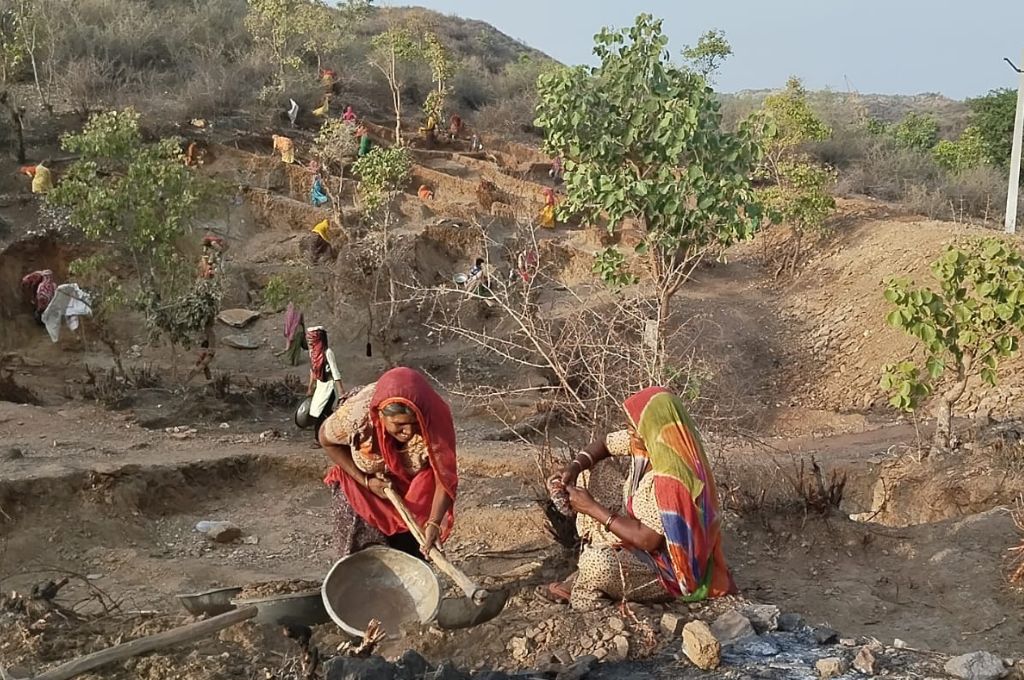In the year 2022, India saw 314 days of extreme weather events, including heavy rains, floods, and landslides. It is estimated that approximately 2 million hectares of cropland and 4.2 lakh houses were damaged last year alone. According to an analysis by the World Meteorological Organization, approximately 1,38,377 Indians have died between 1970 and 2021 in 573 climate-related disasters—the second-highest number in Asia. As such events and their effects on humanity become more pronounced, preparing for disasters and building resilient systems becomes essential. But as we witnessed during the pandemic, many of our systems—including health and service delivery—weren’t equipped to deal with the challenges.
On our podcast On the Contrary by IDR, we spoke to K K Shailaja, former health minister of Kerala, and Liby Johnson, executive director of the nonprofit Gram Vikas. K K Shailaja has received national and global recognition for her leadership and handling of the COVID-19 pandemic and the Nipah virus outbreak in Kerala. Liby has more than 25 years of experience in grassroots and policy work and disaster management. He has coordinated Gram Vikas’s relief, rehabilitation, and reconstruction activities after the 1999 Odisha super cyclone as well as after the 2004 Indian Ocean tsunami.
Liby and Shailaja talked about how a state’s geography and demographics collude to produce a unique set of challenges in each instance, what resilience means and how it can be achieved, the role of civil society, and, in the face of unknown disasters, what preparedness would involve.
Below is an edited transcript that provides an overview of the guests’ perspectives on the show.
Kerala and Odisha: A long history of disasters
Liby Johnson: Natural disasters have been affecting the state [of Odisha] for many years, and in the last five years or so we’ve had annual disaster events—cyclones or floods—recurring on an unprecedented scale. In the middle of [COVID-19] in 2021, a cyclone hit northeast and coastal Odisha. So, the last couple of years have been a struggle. The government of Odisha has put in place some serious, strong early warning systems and one of the advantages of that is the prevention of loss of life during cyclones and similar disasters. This is remarkable progress from what we saw during the 1999 super cyclone.
Odisha has one of the lowest rates of urbanisation in India.
However, 40 percent of Odisha’s population is from scheduled caste or scheduled tribe communities. Approximately two-thirds of the state’s geography is hilly with a large amount of forest cover. The coastal part, which is the remaining third half, has a high density of population and a varied occupational profile. Approximately one-third of Odisha’s GSDP comes from mining and mineral processing industries. So, there’s a lot of ongoing impact on natural resources, such as forests and water, on a daily basis. [There are] five large river basins and annual floods. [The state also has] one of the lowest rates of urbanisation in India, so the economy is very rural and agrarian. But agriculture contributes only 15–16 percent of the gross state product, which necessitates migration at a large scale.
All these factors make Odisha more vulnerable. [During COVID-19, for instance,] the state was not really prepared because of the absence of healthcare facilities at the lowest end. They did try to respond by making panchayats more responsible, but the Panchayati Raj system in Odisha is in its infancy, which compromises its ability to react rapidly.
K K Shailaja: I think Kerala faces the same situation as Odisha, and is also vulnerable to floods and hurricanes. The terrain is similar—with hilly areas and forests. We faced devastating floods in 2018 and 2019, and hurricanes such as Ockhi. There is an increase in pandemics too.
Socio-economically, things are comparatively better for Kerala—the state’s human development index is high because of social reforms such as the Land Reform Act, the total literacy mission, and decentralised planning. Kerala also has the lowest poverty rates in India. But at 860 per square kilometre, the population density is very high, which became a great threat during the pandemic. Lifestyle diseases—hypertension, diabetes, cancer—are also rampant and became a cause of worry during this period.

What does disaster preparedness entail?
1. Building resilience beyond the crisis
Liby Johnson: What Odisha learned from the 1999 super cyclone is how to prevent loss of life. There hasn’t been a double-digit death toll in Odisha due to any disasters that have occurred in the last few years. While that is remarkable, the response to a disaster is still very ad hoc and knee jerk. A lot of preparatory work happens—early warning systems go off, people are moved to cyclone shelters, the National Disaster Response Force (NDRF) begins rescue and relief operations immediately. In everything else, whether it is immediate food relief or shelter support, there’s a lot of arbitrariness, [which is] very surprising considering all the experiences [the state has had]. And we still believe in techno-managerial solutions to all these problems. There are limits to [this approach] because it does not place citizens at the centre.
Resilience is long-term development and the ability of citizens to withstand the shock of an event. [For instance], people may have a majority of their wealth in perishable stocks such as food items and may not have [sufficient] bank balances. In addition, the difference between a family that has a bank balance and one that does not is very stark. So, we have to go back to the basics of development, and remove this aura around disasters as being something that is very different.
K K Shailaja: We think about [people] whenever an incident occurs, and that is not sufficient. To build back better does not mean to reproduce [the same structures] after the flood or the disaster—it means to build back such that people can face these kinds of difficulties.
2. Keeping citizens at the centre of planning and response
Liby Johnson: As a citizen, [when I think about] how I have been dealt with by my government, I get this strong feeling of being a class 2 child who has done something wrong, and of the state being the headmaster. There is this constant sense of worry, fear of the state. The state and the citizen have to be two adults dealing with each other; that is not what is happening. There is [more of] a parent–child relationship between the state and the citizen, especially in Odisha. What is the level of trust that a citizen has in her state, which is manifested either as a panchayat sarpanch, the district collector, or the chief minister?
I think a large number of people in Odisha have great faith in our chief minister to do right. But this is missing at the district level. At the panchayat level, the sarpanch may want to do a lot of things but her hands are tied because the kind of decentralisation that’s happened in Kerala has not happened in Odisha. The policing that happened during COVID-19 is not particularly helpful [in restoring citizens’ faith in authorities]. So [while] we keep the citizen at the centre, at the same time, [we need to ensure that we are] dealing with the citizen as an adult.
3. Focusing on decentralised systems
Liby Johnson: Kerala, Karnataka, and West Bengal are remarkable examples of having effectively managed local-level issues. This is because they followed the subsidiarity principle of institutional design and decision-making, wherein decentralisation was key—let the panchayat, not the collector, decide what it can do. We are now celebrating the silver jubilee of the decentralised planning campaign in Kerala. In 1996, when the Kerala government decided to financially empower panchayats, a lot of people called it money down the drain. But [it’s safe to say] that that’s not the case.
4. Bringing in technology in an inclusive manner
Liby Johnson: We need to bring in technology. However, a lot of new technology interventions are way beyond the average citizen’s reach; they need to be demystified. For instance, how do you make weather forecasts relevant for the farmer and her small plot? What we get is a block-level or district-level forecast, which to the small farmer doesn’t make a difference. How do we demystify it so that the last person can use it?
5. Strengthening primary healthcare and information systems
Liby Johnson: [We need to] reverse what we are doing in the public health system today. Particularly in Odisha, where the focus is on building tertiary specialised care, we are neglecting primary health [systems]. Whether it is a natural disaster or a pandemic, or simple things such as malaria, which has now come back to forests, we cannot leave it to just the ASHAs and the ANMs. And there seems to be so much faith that we have put in our ASHA didis and ANM didis to solve primary health issues [on their own].
K K Shailaja: The pandemic taught us several lessons, [one of which is] that we should equip primary health centres to tackle these kinds of emergencies. We also equipped our laboratories to diagnose diseases earlier, and started improving the secondary- and tertiary-level hospitals. The government now has good operation theatres and wards, with an increased number of beds.
[We also learned that] for pandemics, we should train [healthcare providers] in early detection of the diseases. And we are making people aware about pandemics and diseases. [During COVID-19,] we started [using] the slogan ‘My health is my responsibility’. We are teaching people how to live with the pandemic and infectious diseases.
6. Inculcating partnerships with civil society organisations
Liby Johnson: There were times in Odisha when nonprofits were probably the strongest agents of last-mile social welfare delivery, including disaster relief, or rehabilitation and reconstruction. I remember, in 1999, Gram Vikas worked on rehabilitation and reconstruction for four years after the super cyclone. The state had a very minimal role. That was not the case in 2013, after Cyclone Phailin, when grantmakers played second fiddle to the government as a socio-technical partner, with the state government taking the main role in reconstruction. However, after the 2018 Cyclone Titli or the 2019 Cyclone Fani, [civil society] was not required as a technology or social partner because the state seemed to believe that it could do well on its own.
Odisha also needs organisations to strengthen the panchayat systems.
The state is now providing financial assistance to individual households, and people are making suboptimal habitat planning choices. Habitat planning, that is, designing individual houses as part of the larger environment and keeping in mind public common spaces, has gone completely out of the window. [This is happening] across Odisha—following disasters, individual houses are being built better, but this is not the case for the habitat. This calls for specific skills and technology orientation, of the kind that nonprofits and civil society organisations bring with them.
Odisha also needs organisations to strengthen the panchayat [systems], and this cannot happen by giving more powers to the sarpanch. [Panchayats become stronger] when the citizen–panchayat interface is strengthened. Given the large spread and remote[ness] of locations, and the wide variety in people’s education [levels], [the state] needs a catalyst—[it needs] facilitating organisations. And unfortunately, unlike Kerala and some other states, Odisha does not have a history of people’s movements such as the literacy mission or the social reform movements. So, one has to go back to existing civil society organisations to do that. And that is the nature of partnership we need to bring in.
You can listen to the full episode here.
—





